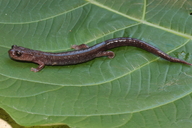|
Pseudoeurycea rex (Dunn, 1921)
| family: Plethodontidae subfamily: Hemidactyliinae genus: Pseudoeurycea |
 © 2013 Sean Michael Rovito (1 of 25) |
|
|
|
Description In life, individuals are dark with an almost black coloration, their dark coloration is likely to be a form of crypsis (Dodd Jr and Brodie Jr 1976). Dunn (1921) describes the species as having pinkish gray coloration on dorsum and dorsal surfaces of the limbs and tail, gray colorations on the lateral surfaces that is marbled with white, and light grey on the ventrum with white marbling on the throat and dorsal surface of the snout. Distribution and Habitat Country distribution from AmphibiaWeb's database: Guatemala, Mexico
Life History, Abundance, Activity, and Special Behaviors Pseudoeurycea rex is a terrestrial breeder with direct developing larvae (Houck 1977). Trends and Threats Possible reasons for amphibian decline General habitat alteration and loss Comments The species was first named Oedipus rex by Emmett Reid Dunn in 1921. Blankers et al. (2012) preformed a large analysis using phylogenies from other studies, morphometric data, and microhabitat use. They showed that P. rex, P. exspectata, P. brunnata form a clade.
References
Acevedo, M., Wake, D., Vasquez, C., Rovito, S. 2008. Pseudoeurycea rex. The IUCN Red List of Threatened Species 2008: e.T59392A11916292. http://dx.doi.org/10.2305/IUCN.UK.2008.RLTS.T59392A11916292.en. Downloaded on 21 June 2017. Blankers, T., Adams, D.C., Wiens, J.J. (2012). ''Ecological radiation with limited morphological diversification in salamanders.'' Journal of Evolutionary Biology, 25, 634–646. Cheng, T.L., Rovito, S.M., Wake, D.B., Vredenburg, V.T. (2011). ''Coincident mass extirpation of neotropical amphibians with the emergence of the infectious fungal pathogen Batrachochytrium dendrobatidis.'' Proc. Natl. Acad. Sci., 108, 9502–9507. Cheng, T.L.T. (2011). Impacts of an amphibian pathogen, Batrachochytrium dendrobatidis, in Mesoamerica and Taiwan. Master's Thesis. San Francisco State University. Dodd, C. K., Jr. and Brodie, E. D., III (1976). ''Defensive mechanisms of Neotropical salamanders with an experimental analysis of immobility and the effect of temperature on immobility.'' Herpetologica, 32(3), 269-290. Dunn, E.R. (1921). ''Two new Central American salamanders.'' Proc. Biol. Soc. Wash., 34, 143–145. Houck, L.D. (1977). ''Life history patterns and reproductive biology of neotropical salamanders.'' The Reproductive Biology of Amphibians. Taylor, D.H., Guttman, S.I., eds., Springer, New York, New York, 43–72. Rovito, S., Parra-Olea, G., Vásquez-Almazán, C. R., Papenfuss, T. J., and Wake, D. B. (2009). ''Dramatic declines in neotropical salamander populations are an important part of the global amphibian crisis.'' Proceedings of the National Academy of Sciences of the United States of America, 106(9), 3231-3236. Wake, D. B. (1987). ''Adaptive radiation of salamanders in Middle American cloud forests.'' Annals of the Missouri Botanical Garden, 74(2), 242-264. Originally submitted by: Kenneth Anderson (first posted 2017-06-22) Edited by: Ann T. Chang and Jarrett Johnson (2017-06-22) Species Account Citation: AmphibiaWeb 2017 Pseudoeurycea rex <https://amphibiaweb.org/species/4186> University of California, Berkeley, CA, USA. Accessed May 22, 2025.
Feedback or comments about this page.
Citation: AmphibiaWeb. 2025. <https://amphibiaweb.org> University of California, Berkeley, CA, USA. Accessed 22 May 2025. AmphibiaWeb's policy on data use. |




 Raffaëlli Account
Raffaëlli Account Map of Life
Map of Life